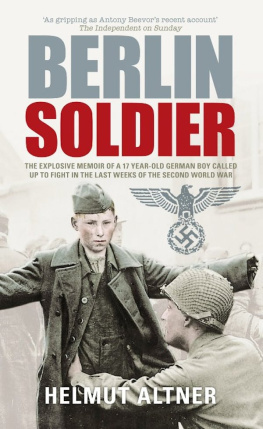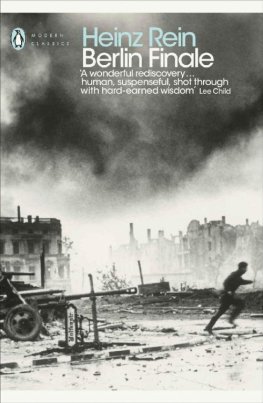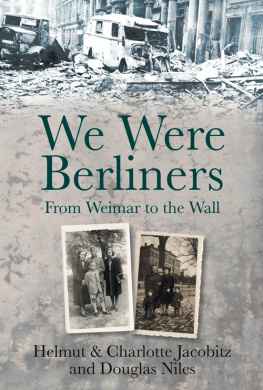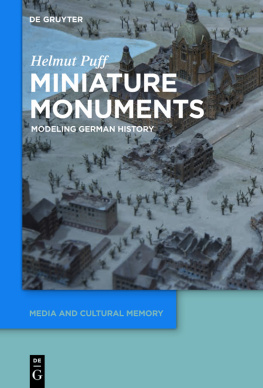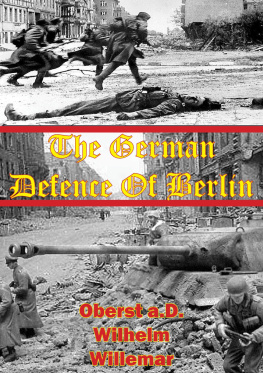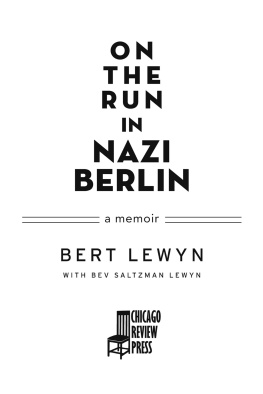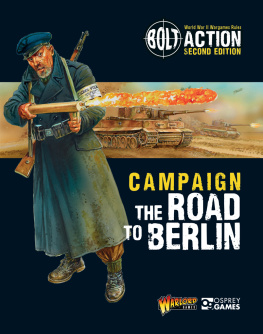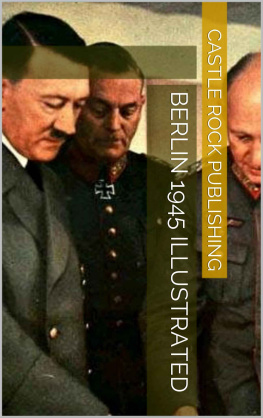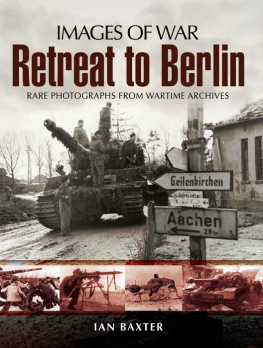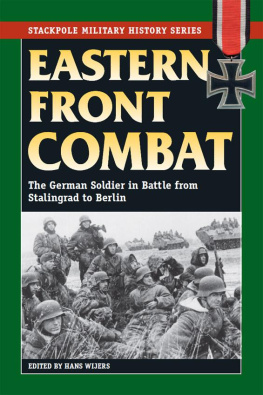BERLIN
SOLDIER
About the Author
Helmut Altner, the author, worked for decades as the Paris correspondent of several German newspapers, and has now retired to live just outside the city.
Tony Le Tissier, the translator and editor, is an acknowledged expert on the 1945 battle of Berlin. His other books include, The Battle of Berlin 1945 (also published by Tempus), Slaughter at Halbe: The Destruction of Hitlers 9th Army - April 1945, With Our Backs to Berlin: The German Army in Retreat 1945, Death Was Our Companion: The Final Days of the Third Reich, Farewell to Spandau, and Berlin Then and Now. He lives in Lymington in Hampshire.

This edition first published in 2007 by Tempus Publishing
Reprinted in 2008 by
The History Press
The Mill, Brimscombe Port,
Stroud, Gloucestershire, GL5 2QG
This ebook edition first published 2016
All rights reserved
Helmut Altner, 2002, 2007
Translation, Annotations and illustrations
copyright A H Le Tissier 2002, 2007
The right of Helmut Altner and A H Le Tissier to be identified as the Authors of this work has been asserted in accordance with the Copyrights, Designs and Patents Act 1988.
This ebook is copyright material and must not be copied, reproduced, transferred, distributed, leased, licensed or publicly performed or used in any way except as specifically permitted in writing by the publishers, as allowed under the terms and conditions under which it was purchased or as strictly permitted by applicable copyright law. Any unauthorised distribution or use of this text may be a direct infringement of the authors and publishers rights, and those responsible may be liable in law accordingly.
EPUB ISBN 978 0 7509 7979 5
Typesetting and origination by Tempus Publishing Limited
eBook converted by Geethik Technologies
Contents
Introduction
This is a teenagers vivid account of his experiences as a conscript during the final desperate weeks of the Third Reich, during which he experienced training immediately behind the front line east of Berlin, was caught up in the massive Soviet assault on Berlin from the Oder, retreated successfully, and then took part in the fight for the western suburb of Spandau, where he became one of the only two survivors of his company of 17-year-olds. He later fought in the U-Bahn tunnels and in the battle for the Reichssportfeld. Then, on the morning the city capitulated, he took part in the breakout to the west that turned into a bloodbath for soldiers and civilians alike. Wounded, he was captured near Brandenburg on 3 May 1945.
The detailed description of his experiences makes it still possible today over fifty years later to walk in his footsteps. His book, based on notes made in a diary that survived eighteen months of Soviet captivity, was originally published in Offenbach in the spring of 1948 after clearance with the US Military Government and the necessary allocation of paper to print it on.
Helmut Altners account ties in with events outside his knowledge as a simple soldier, so I have supplemented his text in this revised edition with notes, drawings, appendices and photographs. His regimental command post, for example, was located in an underground factory that had last been used for assembling V-Weapons, but had actually been intended for the production of poison gas and eventually was to be used by the Soviet Army as a secret headquarters in case of nuclear warfare.
Two words or expressions used in the translation will perhaps strike todays reader as rather odd: child as applied to a 17-year-old and comrade. At the, time of the Third Reich there was no word for teenager in the German language, and the use of the word comrade has been maintained from the original German text as it had a specific meaning for the German soldier for which I can find no adequate English equivalent.
Tony Le Tissier
Frome
February 2002
1
Called Up
Thursday 29 March 1945
Berlin seems to be falling apart at the seams. The nightly bombing raids have inflicted far greater damage than the official communiques indicate. According to them only a few buildings in Spandau have been destroyed, but the actual situation looks far worse. The U is running irregularly, and half hour delays are no exception, while the S-Bahn, with most of the tracks damaged beyond recognition, is almost completely at a standstill.
I am standing hemmed in between thrusting, pushing passengers on an S-Bahn train between Velten and Hennigsdorf. My luggage, which consists of a Persil carton containing something to eat and some underwear, is stuffed somewhere in the carriages luggage rack. At Hennigsdorf I am forced out onto the platform by the rush and have to use my elbows ruthlessly to get back in to recover my baggage and then jump off the already moving train.
I follow the stream of people down the steps to the station exit, the call-up papers in my pocket already making me feel as if I no longer belong with these people. I make my way to the tram stop from where a tram should take me to where I have to report. The traffic island is already full of people who cram into the tram when it arrives. As everywhere in the Berlin street scene, the field-grey uniform predominates.
After a short while the conductor rings the bell and we move off. I stand on the rear platform and can see the road go by. We leave Hennigsdorf behind us and pass through meadows and woodland to where Route 120 comes to an end and the connecting tram is waiting for us. Soon the first villas in Spandau appear and we can see the consequences of last nights bombing. Ripped apart sections of woodland and shattered venerable old oak trees bear witness to the destructive effectiveness of modern explosives. Then burning houses whisk by, attended to by troops of soldiers and Hitlerjugend armed with fire-extinguishing equipment, while several boys in uniform collect up torn apart pieces of human bodies and a 12-year-old stands by calmly eating his breakfast roll.
The tram stops and we have to get off. I take my carton and go on past the wagon. Several metres farther on the overhead cables have been destroyed and are strewn across the road. We will have to wait to see how we can go on.
A few others with Persil cartons have got off the tram with me, and after some hesitant glances, contact is established; we all have the same goal.
With a combined effort we manage to stop a truck, which quickly fills with people converging from all directions, men and women who are clearly moving out of certain areas and others wanting to visit their relatives in the bombed parts of the city to find out if they are still alive. Every vehicle we come across is full of exhausted people. Rumours, every one worse than the other, swirl about us, making us even more unsettled than before.
We rapidly approach the centre of Spandau and here, for the first time, we see the powerful extent of the damage. The empty window frames of a burnt-out factory across the way stare accusingly at the world, fallen beams glowing gently and occasionally flaring up with the breeze, while the owners of a still burning house watch from across the street speechlessly as the fruits of years of hard toil go sky high. Dark figures slink through the destroyed quarter, looking about them furtively like hyenas on the prowl. Berlin, the nerve centre of the Reich, has been turned upside down.
The farther we penetrate this destroyed, burning quarter, the more depressed we get by the atmosphere. Women are crying quietly, stopping people to ask anxiously about certain streets and if many have been killed. They are answered in low voices. One no longer recognises in these faces the heroism mentioned so often by Goebbels in the first years of the war. On the contrary, one sees only a dull, undisguised despair.
Next page
